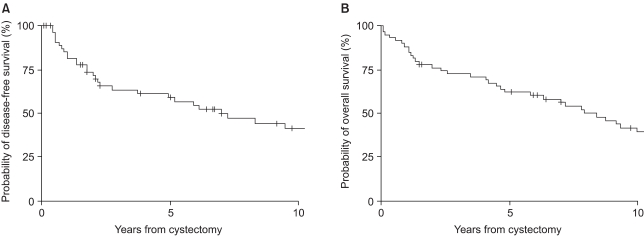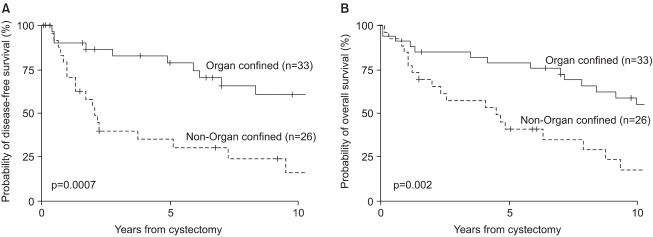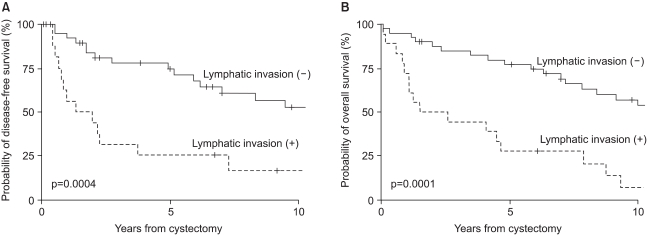Cancer Res Treat.
2005 Feb;37(1):48-53.
Clinical Prognostic Factors for Radical Cystectomy in Bladder Cancer
- Affiliations
-
- 1Department of Urology, School of Medicine, Kyung Hee University, Seoul, Korea. sgchang@khu.ac.kr
Abstract
- PURPOSE
We investigated the effects of radical cystectomy and the prognostic factors that affect the survival of bladder cancer patients. MATERIALS AND METHODS: From 1979 to 2002, 59 patients with long-term follow up results of at least 2 years were enrolled in this study. Indications for surgery included muscle invasive bladder cancer and high-risk superficial bladder cancer. The cancer specific and recurrence free survival rates with respect to the possible prognostic factors were determined using Kaplan-Meier statistics. RESULTS: The mean patient age was 62.8 years (M: 48, F: 11), and the estimated 5- and 10-year survival rates were 62% and 39.4%, respectively. The median time to local or systemic recurrence was 16 months (range: 5~100), and the average survival durations after local and systemic recurrence were 14.4 months and 12.7 months, respectively. Pathologic stage, tumor grade, mean nuclear area, sex and lymphatic invasion were significant factors by univariate analysis (p<0.05). The disease related survival rate in patients having progression from an initial superficial tumor was lower than for those patients who displayed muscle invasive disease at the initial treatment. Multivariate analysis identified pathologic stage and lymphatic invasion as independent prognostic factors. CONCLUSIONS: Radical cystectomy for organ-confined cancer showed favorable 5- and 10-year survival rates. The survival rate for patients with progression from an initial superficial tumor was worse than for those patients with invasive tumor at the initial presentation. The most significant independent prognostic factors were the pathologic stage and the presence of lymphatic invasion, which were highly correlated with all the investigated disease endpoints.
MeSH Terms
Figure
Reference
-
1. Lee C, Lee ES, Choi H, Koh SK, Lee JM, Chai SE, et al. Incidence estimation of genitourinary cancer in Korea. J Korean Med Sci. 1992; 7:154–161. PMID: 1524728.
Article2. Prout GR Jr, Griffin PP, Shipley WU. Bladder carcinoma as a systemic disease. Cancer. 1979; 43:2532–2539. PMID: 455239.
Article3. Babaian RJ, Johnson DE, Llamas L, Ayala AG. Metastases from transitional cell carcinoma of the urinary bladder. Urology. 1980; 16:142–144. PMID: 7404907.4. Skinner DG, Daniels JR, Russell CA, Lieskovsky G, Boyd SD, Nichols P, et al. The role of adjuvant chemotherapy following cystectomy for invasive bladder cancer: a prospective comparative trial. J Urol. 1991; 145:459–464. PMID: 1997689.
Article5. Herr HW. Transurethral resection of muscle-invasive bladder cancer: 10-year outcome. J Clin Oncol. 2001; 19:89–93. PMID: 11134199.
Article6. Sternberg CN. Current perspectives in muscle invasive bladder cancer. Eur J Cancer. 2002; 38:460–467. PMID: 11872337.
Article7. Stein JP, Lieskovsky G, Cote R, Groshen S, Feng AC, Boyd S, et al. Radical cystectomy in the treatment of invasive bladder cancer: long-term results in 1,054 patients. J Clin Oncol. 2001; 19:666–675. PMID: 11157016.
Article8. Pagano F, Bassi P, Galetti TP, Meneghini A, Milani C, Artibani W, et al. Results of contemporary radical cystectomy for invasive bladder cancer: a clinicopathological study with an emphasis on the inadequacy of the tumor, nodes, and metastases classification. J Urol. 1991; 145:45–50. PMID: 1984097.
Article9. Bosl GJ. Controversies in the management of transitional cell carcinoma of the bladder. American Society of Clinical Oncology Educational Book. 1991. p. 73–88.10. Bol MG, Baak JP, Rep S, Marx WL, Kruse AJ, Bos SD, et al. Prognostic value of proliferative activity and nuclear morphometry for progression in TaT1 urothelial cell carcinomas of the urinary bladder. Urology. 2002; 60:1124–1130. PMID: 12475695.
Article11. Ozer E, Yorukoglu K, Mungan MU, Ozkal S, Demirel D, Sagol O, et al. Prognostic significance of nuclear morphometry in superficial bladder cancer. Anal Quant Cytol Histol. 2001; 23:251–256. PMID: 11531139.12. Moran A, Sowerbutts AM, Collins S, Clarke N, Cowan R. Bladder cancer: worse survival in women from deprived areas. Br J Cancer. 2004; 90:2142–2144. PMID: 15150549.
Article13. Narayana AS, Loening SA, Sylmen DJ, Culp DA. Bladder cancer: factors affecting survival. J Urol. 1983; 130:56–60. PMID: 6864915.
Article
- Full Text Links
- Actions
-
Cited
- CITED
-
- Close
- Share
- Similar articles
-
- Continent ileal reservoir after radical cystectomy for bladder tumor
- Prognostic Significance of the Presence of Proper Muscle in the Resected Specimens of Primary T1G3 Bladder Cancer
- Retrospective Survival Analysis according to Prognostic Factors after Radical Cystectomy in Bladder Cancer
- Risk Factors Leading to Radical Cystectomy in Patients Who Had Undergone Nephroureterectomy
- Radical Cystectomy with Pelvic Lymphadenectomy in Bladder Tumor: Review of 14 Cases




